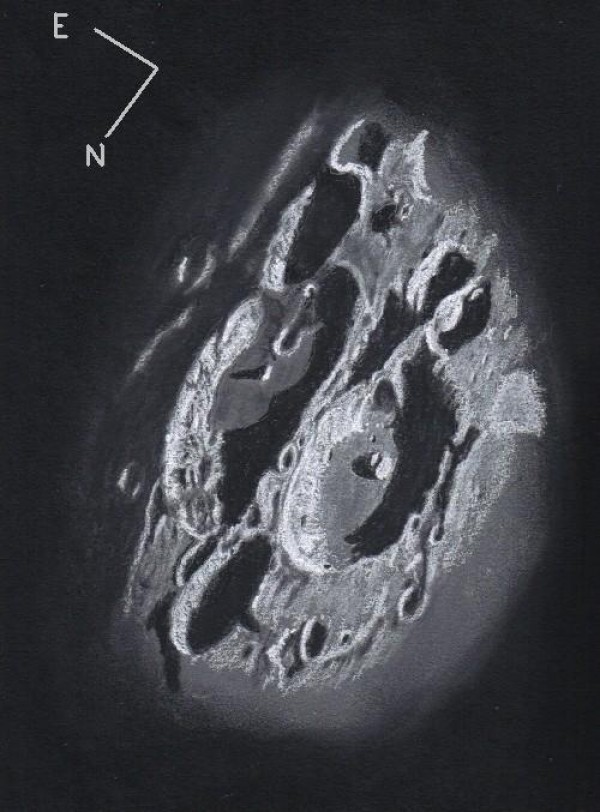This sketch was made on an exceptionally steady night of seeing and centers on two old craters in the highlands of the southeastern quadrant near the approaching sunset terminator. At times of higher sun the dominating feature here is a uniform scattering of similar looking 30-50 km. craters that dot this highland plain. It is something of a nightmare to identify small impactors in this local. This region looks and is ancient. Here you will find two large sketching targets side by side, the craters Rosenberger (96km.) and Vlacq (89 km.).
Both of these craters pre-date the impact that formed the Nectaris basin some 3.9 billion years ago. As obviously ancient as these craters appear at high sun with the worn out rims, lack of large central peaks, lack of ejecta blanket rays, etc. At a low sun angle this pair takes on a more youthful appearance. The sharp shadows hide some tell tale signs of age. The smaller of the two, namely Vlacq is noticeably more youthful, with its larger, central, double massif, lower floor crater count and slight bulge inward onto Rosenberger.
It was a pleasure under near perfect weather conditions to observe and sketch this pair again at the eyepiece after 3 years hiatus.
Sketching:
For this sketch I used: black Strathmore 400 Artagain paper, 9”x 12”, white and black Conte’pastel pencils and blending stumps, gum eraser, brush. Brightness was slightly decreased with the scanner.
Telescope: 10 inch f/ 5.7 Dobsonian and 6 mm eyepiece 241 x
Date: 8-28-2010, 6:30-8:20 UT
Temperature: 22° C (72° F)
clear, calm
Seeing: Antoniadi II
Colongitude: 133.2 °
Lunation: 18.1 days
Illumination: 88.8% Waning Gibbous
Frank McCabe

Frank
That is a very complex set of craters.
Nice work.
Scott.
Frank
Amazing view, beautiful light! Full reality!
Aleksander
Scott and Aleksander,
Thanks a bunch for the nice words.
Frank 🙂
It’s amazing and beautiful picture. Great is not enough word.
The data information what you used for the picture, it would be help for others like me.
Stella J
Stella,
Thank you.
If you are asking about how I know what craters these are on the moon and the information about them. I have a good collection of lunar charts, atlases and written works that I have collected since the 1950’s. You can download on to your home computer the ‘Virtual Moon Atlas’ by Patrick Chevalley and it is free. A very good on-line atlas of the moon. For more recent information about the moon you can’t beat the writings of Chuck Wood and other contributors daily at ‘Lunar Photo of the Day’ on the web. Chuck Wood also writes a column monthly in Sky and Telescope magazine and has for many years.
You can also find information and tutorials about sketching the moon at Cloudy Nights Telescope Reviews just go to the Forums and scroll down to the Sketching Forum and below that the Lunar Observing Forum.
I hope this helps.
Frank 🙂